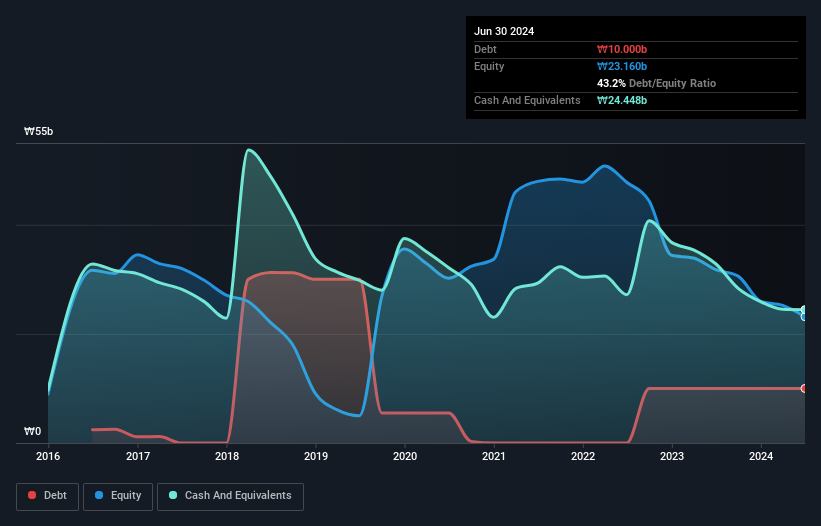Some say volatility, rather than debt, is the best way to think about risk as an investor, but Warren Buffett famously said that 'Volatility is far from synonymous with risk.' So it seems the smart money knows that debt - which is usually involved in bankruptcies - is a very important factor, when you assess how risky a company is. We note that Thumbage Co., Ltd. (KOSDAQ:208640) does have debt on its balance sheet. But should shareholders be worried about its use of debt?
When Is Debt A Problem?
Debt assists a business until the business has trouble paying it off, either with new capital or with free cash flow. In the worst case scenario, a company can go bankrupt if it cannot pay its creditors. While that is not too common, we often do see indebted companies permanently diluting shareholders because lenders force them to raise capital at a distressed price. Of course, plenty of companies use debt to fund growth, without any negative consequences. When we examine debt levels, we first consider both cash and debt levels, together.
View our latest analysis for Thumbage
How Much Debt Does Thumbage Carry?
The chart below, which you can click on for greater detail, shows that Thumbage had ₩10.0b in debt in June 2024; about the same as the year before. However, its balance sheet shows it holds ₩24.4b in cash, so it actually has ₩14.4b net cash.

A Look At Thumbage's Liabilities
According to the last reported balance sheet, Thumbage had liabilities of ₩12.0b due within 12 months, and liabilities of ₩1.08b due beyond 12 months. On the other hand, it had cash of ₩24.4b and ₩1.20b worth of receivables due within a year. So it can boast ₩12.6b more liquid assets than total liabilities.
This luscious liquidity implies that Thumbage's balance sheet is sturdy like a giant sequoia tree. Having regard to this fact, we think its balance sheet is as strong as an ox. Succinctly put, Thumbage boasts net cash, so it's fair to say it does not have a heavy debt load! The balance sheet is clearly the area to focus on when you are analysing debt. But you can't view debt in total isolation; since Thumbage will need earnings to service that debt. So if you're keen to discover more about its earnings, it might be worth checking out this graph of its long term earnings trend.
In the last year Thumbage wasn't profitable at an EBIT level, but managed to grow its revenue by 12%, to ₩15b. That rate of growth is a bit slow for our taste, but it takes all types to make a world.
So How Risky Is Thumbage?
By their very nature companies that are losing money are more risky than those with a long history of profitability. And in the last year Thumbage had an earnings before interest and tax (EBIT) loss, truth be told. Indeed, in that time it burnt through ₩6.3b of cash and made a loss of ₩11b. While this does make the company a bit risky, it's important to remember it has net cash of ₩14.4b. That means it could keep spending at its current rate for more than two years. Overall, its balance sheet doesn't seem overly risky, at the moment, but we're always cautious until we see the positive free cash flow. When analysing debt levels, the balance sheet is the obvious place to start. However, not all investment risk resides within the balance sheet - far from it. For example Thumbage has 2 warning signs (and 1 which is a bit unpleasant) we think you should know about.
At the end of the day, it's often better to focus on companies that are free from net debt. You can access our special list of such companies (all with a track record of profit growth). It's free.
Valuation is complex, but we're here to simplify it.
Discover if Thumbage might be undervalued or overvalued with our detailed analysis, featuring fair value estimates, potential risks, dividends, insider trades, and its financial condition.
Access Free AnalysisHave feedback on this article? Concerned about the content? Get in touch with us directly. Alternatively, email editorial-team (at) simplywallst.com.
This article by Simply Wall St is general in nature. We provide commentary based on historical data and analyst forecasts only using an unbiased methodology and our articles are not intended to be financial advice. It does not constitute a recommendation to buy or sell any stock, and does not take account of your objectives, or your financial situation. We aim to bring you long-term focused analysis driven by fundamental data. Note that our analysis may not factor in the latest price-sensitive company announcements or qualitative material. Simply Wall St has no position in any stocks mentioned.
About KOSDAQ:A208640
Adequate balance sheet with slight risk.
Market Insights
Community Narratives



